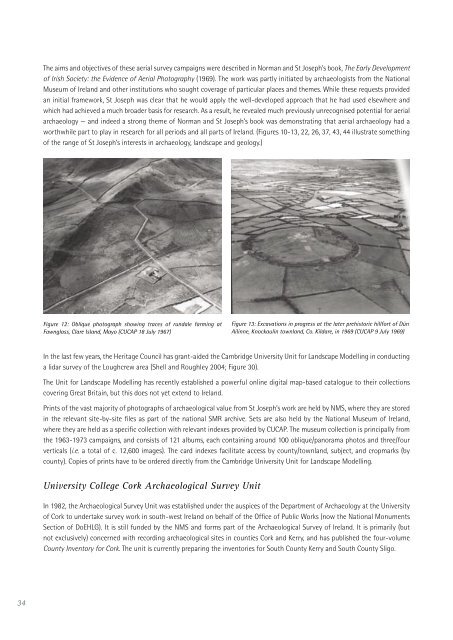Aerial Archaeology in Ireland - The Heritage Council
Aerial Archaeology in Ireland - The Heritage Council
Aerial Archaeology in Ireland - The Heritage Council
You also want an ePaper? Increase the reach of your titles
YUMPU automatically turns print PDFs into web optimized ePapers that Google loves.
34<br />
<strong>The</strong> aims and objectives of these aerial survey campaigns were described <strong>in</strong> Norman and St Joseph’s book, <strong>The</strong> Early Development<br />
of Irish Society: the Evidence of <strong>Aerial</strong> Photography (1969). <strong>The</strong> work was partly <strong>in</strong>itiated by archaeologists from the National<br />
Museum of <strong>Ireland</strong> and other <strong>in</strong>stitutions who sought coverage of particular places and themes. While these requests provided<br />
an <strong>in</strong>itial framework, St Joseph was clear that he would apply the well-developed approach that he had used elsewhere and<br />
which had achieved a much broader basis for research. As a result, he revealed much previously unrecognised potential for aerial<br />
archaeology — and <strong>in</strong>deed a strong theme of Norman and St Joseph’s book was demonstrat<strong>in</strong>g that aerial archaeology had a<br />
worthwhile part to play <strong>in</strong> research for all periods and all parts of <strong>Ireland</strong>. (Figures 10-13, 22, 26, 37, 43, 44 illustrate someth<strong>in</strong>g<br />
of the range of St Joseph’s <strong>in</strong>terests <strong>in</strong> archaeology, landscape and geology.)<br />
Figure 12: Oblique photograph show<strong>in</strong>g traces of rundale farm<strong>in</strong>g at<br />
Fawnglass, Clare Island, Mayo (CUCAP 18 July 1967)<br />
Figure 13: Excavations <strong>in</strong> progress at the later prehistoric hillfort of Dún<br />
Ail<strong>in</strong>ne, Knockaul<strong>in</strong> townland, Co. Kildare, <strong>in</strong> 1969 (CUCAP 9 July 1969)<br />
In the last few years, the <strong>Heritage</strong> <strong>Council</strong> has grant-aided the Cambridge University Unit for Landscape Modell<strong>in</strong>g <strong>in</strong> conduct<strong>in</strong>g<br />
a lidar survey of the Loughcrew area (Shell and Roughley 2004; Figure 30).<br />
<strong>The</strong> Unit for Landscape Modell<strong>in</strong>g has recently established a powerful onl<strong>in</strong>e digital map-based catalogue to their collections<br />
cover<strong>in</strong>g Great Brita<strong>in</strong>, but this does not yet extend to <strong>Ireland</strong>.<br />
Pr<strong>in</strong>ts of the vast majority of photographs of archaeological value from St Joseph’s work are held by NMS, where they are stored<br />
<strong>in</strong> the relevant site-by-site files as part of the national SMR archive. Sets are also held by the National Museum of <strong>Ireland</strong>,<br />
where they are held as a specific collection with relevant <strong>in</strong>dexes provided by CUCAP. <strong>The</strong> museum collection is pr<strong>in</strong>cipally from<br />
the 1963-1973 campaigns, and consists of 121 albums, each conta<strong>in</strong><strong>in</strong>g around 100 oblique/panorama photos and three/four<br />
verticals (i.e. a total of c. 12,600 images). <strong>The</strong> card <strong>in</strong>dexes facilitate access by county/townland, subject, and cropmarks (by<br />
county). Copies of pr<strong>in</strong>ts have to be ordered directly from the Cambridge University Unit for Landscape Modell<strong>in</strong>g.<br />
University College Cork Archaeological Survey Unit<br />
In 1982, the Archaeological Survey Unit was established under the auspices of the Department of <strong>Archaeology</strong> at the University<br />
of Cork to undertake survey work <strong>in</strong> south-west <strong>Ireland</strong> on behalf of the Office of Public Works (now the National Monuments<br />
Section of DoEHLG). It is still funded by the NMS and forms part of the Archaeological Survey of <strong>Ireland</strong>. It is primarily (but<br />
not exclusively) concerned with record<strong>in</strong>g archaeological sites <strong>in</strong> counties Cork and Kerry, and has published the four-volume<br />
County Inventory for Cork. <strong>The</strong> unit is currently prepar<strong>in</strong>g the <strong>in</strong>ventories for South County Kerry and South County Sligo.

















